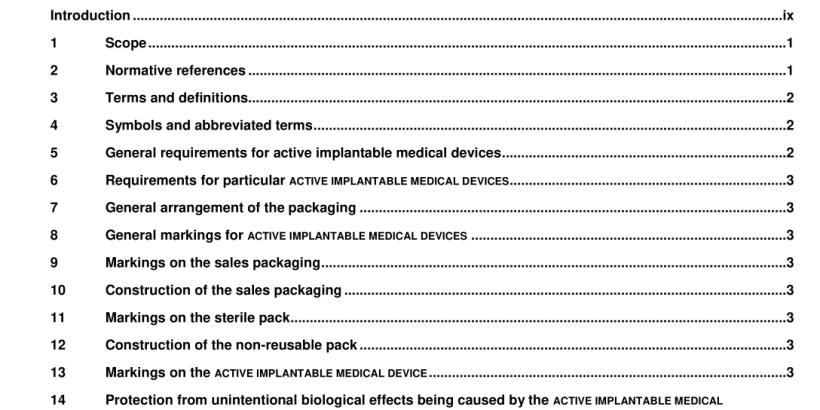ANSI AAMI ISO 14708-3-2017 pdf download
ANSI AAMI ISO 14708-3-2017 pdf download.Implants for surgery — Active implantable medical devices
Prior to testing, risks shall be identified, taking into account the reasonably foreseeable electromagnetic (EM) environment that is likely to occur during its intended use. Immunity test levels in Clause 27 are based on the reasonably foreseeable maximum levels found in the general public EM environment. Each risk shall be evaluated through a design analysis that takes account of any risk control, according to ISO 1 4708-1 :201 4, 5.5.4. The risk assessment process, performed in accordance with ISO 1 4971 , could result in hazardous situations being identified (see ISO 1 4971 :2007, Figure E.1 ). Since actual risk cannot be observed during testing, it will be necessary to observe the performance of the device to see if any hazardous situations occur. Pass/fail criteria shall be defined prior to testing. Ideally, these criteria can be measurable or observable during testing. If not, the manufacturer shall specify an alternative method for determining that the DUT met the required pass/fail criteria during the test. The use of special hardware or software might be necessary. If the pass/fail acceptance criteria are not met during and after testing, the manufacturer shall substantiate DUT behavioural responses and explain why the overall risk(s) are acceptable (see Table 1 03). In no cases are irreversible changes in performance, outside of specification, allowed.
For all tests, provision shall be made to determine the device’s behavioural responses, preferably during testing. If the operation of the DUT cannot be observed or verified during the test, the manufacturer shall specify an alternative method for determining that the DUT met the required pass/fail criteria during the test. The use of special hardware or software might be necessary.
27.102.3 Operating functions, modes, and settings
The INS shall be tested using the functions, modes, and settings, consistent with intended use, that are likely to be the most susceptible to EM disturbances. This shall be determined using risk analysis, experience, engineering analysis, or pretesting. Except for the requirements of 5.1 01 , if the intended use includes a wireless communication channel, the wireless communication function shall be evaluated and tested for EMC in accordance with IEC 60601 -1 -2. NOTE A wireless communication function does not have to be tested twice for EMC, as it would be if it were tested according to this document and IEC 60601 -1 -2.
27.102.4 Patient physiological simulation
If simulation of the patient is required to verify normal operation of the INS, it shall be provided during immunity testing. Physiological simulation shall not provide an intentional conductive or capacitive connection to earth other than that required by 27.1 02.2.
The tissue-electrode interface model simulates the impedance created by the tissue-electrode interface and also matches signal generator output to the injection circuit. The injected test voltage (V PP ) is based on the theoretical open circuit voltage (V OC ) seen across the entire INS system. The interface model would not have to be used but then the entire test voltage would be applied across the IPG and leads. In actual practice, the voltage presented to the IPG is less by a relative amount. NOTE Annex BB describes the determination of V OC and V PP used in this subclause. The low pass filter provides points where the monitoring oscilloscope can be connected to observe DUT output stimulation waveforms during the test. Without this filter, it would be more difficult to separate the injected signal from the DUT output waveform. The lead interface simulates the therapy lead impedance. This may be accomplished by using an actual lead or by circuit model simulation of an actual lead. Both approaches are represented in Figure 1 01 . Test procedure: A test signal generator, monitoring oscilloscopes, and the DUT are connected to the injection network as indicated in Figure 1 01 . DUT output stimulation will need to be selected so that the output waveform can be reasonably monitored throughout the test. If the design of the DUT is equivalent for all electrodes, then only one configuration needs to be tested (see 27.1 02.2). In that case, it is not necessary to exercise several combinations of anodes and cathodes.
